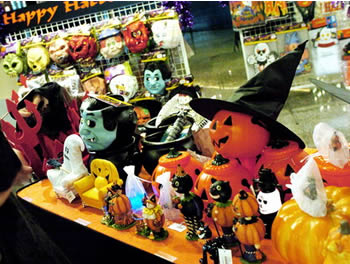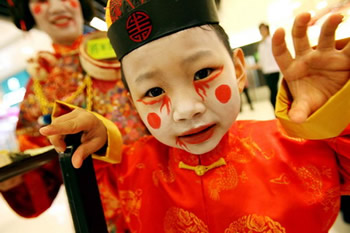万圣节看中外“鬼”风俗

面对中、西方文化的比拼,比如西方情人节VS东方七夕节、西方感恩节VS中国重阳节,孰是孰非,网上热谈高温不退。对于明天的万圣节,有数据统计,中国的“鬼”精灵届时会史无前例。大家在狂欢、恶搞的同时,不妨也再来个比较:西方万圣节VS中国鬼节。从这两个节日的传说来看,都是与鬼有关的。随着时间流逝,万圣节的意义逐渐起了变化,变得积极快乐起来。而中国阴历7月15日也被认为是鬼门关大开,阴间的鬼魂回到阳间来控望亲人,但却增加了几分沉重,在这一天,中国民间有在河中放船灯的习俗。
But there is no need to be frightened. This is only because Halloween is becoming more and more popular, with hordes of revellers dressing up as ghosts, goblins and witches.
This year the festival is being given a modern twist, as many young Chinese send e-Halloween cards and have online parties.
There is even a tug-of-war in cyberspace between supporters of Western ghosts in black cloaks, and fans of Chinese ones who stick out their long tongues. The latter group is calling for a revival of local ghosts as foreign ones begin to take over.
"There is a 'ghost festival' in China that is more than two thousand years old," one claimed at the popular online forum Tianya.com. "These 'expat ghosts' are not going to be the winners who take all."
No matter which side they are on, Chinese netizens have never shown such interest in ghosts.
Major websites in China such as Sina.com, Sohu.com and 163.com are all offering e-greetings for Halloween on their home pages. A popular e-card at Sohu.com featuring a cute black-cloaked, green-faced ghost has been sent more than 20,000 times.

Halloween in China is a "crazy night" for young people now, according to Sheila Shi, a website editor in Beijing.
The revellers probably don't know the origins of Halloween, which go back to ancient Celtic traditions in Ireland. According to Celtic mythology, November 1 marked the end of summer, and it was then that the boundaries between the natural and the supernatural were believed to disappear, and spirits of the dead moved freely among the human world.
It's interesting to see certain parallels with the Chinese ghost festival, also known as the Hungry Ghost Festival in southern China and Southeast Asia. It falls on July 15 of the lunar calendar, or mid-August of the Gregorian calendar.

On that day, Chinese legend says, the gate to hell is opened at midnight, and ghosts swarm into the world of human beings in search of food and money.
These ghosts, who have been starving for a whole year, will enter households if they cannot find enough delicacies in the street. Therefore, people in southern China traditionally put chicken, meat, vegetables, rice, tea and fruit on their doorsteps that day.
In other parts of the country people simply burn pieces of paper resembling currency notes, and in larger cities in East China, such as Shanghai and Hangzhou, the ghosts are now welcomed by candles lit along the street.
According to website editor Shi, the streets that night are empty in Chongqing, as few dare leave their house. "They say if a ghost finds you in the street and follows you back home, your family will have bad luck all year," she said.
"All in all, people should be very careful during the Chinese ghost festival; they have to keep away from ghosts and not offend them. It's really not as much fun as Halloween."
词汇:
goblin: 顽皮的小鬼,被认为常搞恶作剧
tug-of-war : 激烈的争夺、斗争;拔河
black-cloaked:穿黑色长袍的(鬼)
 每年的10月31日是西方传统节日万圣节(Halloween),当晚小孩会穿上化妆服,戴上面具,挨家挨户收集榶果。
每年的10月31日是西方传统节日万圣节(Halloween),当晚小孩会穿上化妆服,戴上面具,挨家挨户收集榶果。
相关链接:
类似于圣诞节和复活节,万圣节也来自于基督教对其它宗教的节日的吸收、改造和重新诠释。万圣节起源于不列颠凯尔特人的传统节日,在10月的最后一天,他们相信这是夏天的终结,冬天的开始,这一天是一年的重要标志,是最重要的节日之一,被称为“死人之日”,或者“鬼节”。这一天各种恶鬼出没,死去人们的灵魂也会离开身体,在世间游走,这一天的晚上也就格外危险。人们会把食物放在门口吸引有主的鬼魂灵魂,而为了吓走邪恶的鬼魂,凯尔特人会载上面具。
通常与万圣节扯上关系的事物有鬼魂、食尸鬼、巫婆、蝙蝠、黑猫、猫头鹰、精灵、僵尸、骷髅和恶魔等,还有虚构人物如吸血僵尸和科学怪人。黑色和橙色是万圣节的传统颜色。现代万圣节的产品也大量使用紫色、绿色和红色。秋天的元素如南瓜和稻草人等,也成为万圣节的象征。
A spine-tingling statistic: China's ghost population will boom tomorrow.
>>点击查看更多关于英语文化的文章

